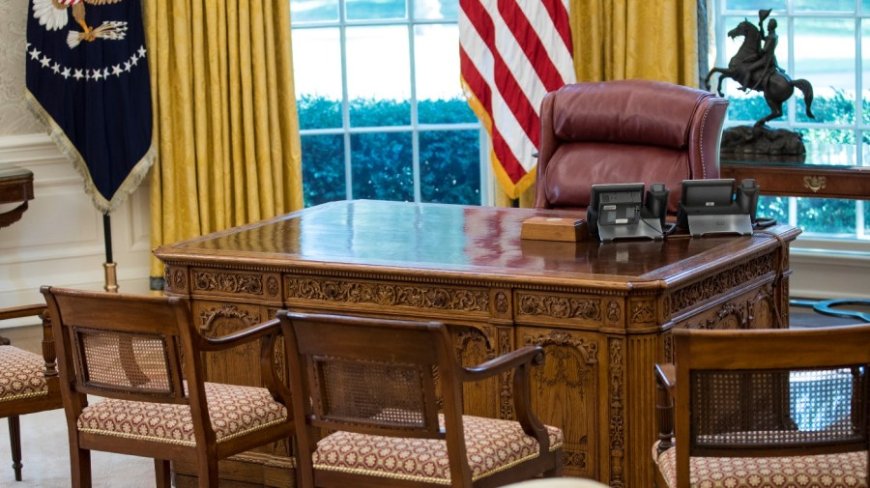5 myths about presidential transitions
Each of the last four transfers of power was marked by deep partisan discord.

Make no mistake, the chaos of our last presidential transition was bad — one impeachment and two criminal cases bad.
And yet, we are now two months away from a transition to either Trump Two or Harris One.
Former President Donald Trump and Vice President Kamala Harris have each announced their transition directors. As each side begins to plan, here are five myths worth reconsidering:
Myth 1: Smooth transitions are the norm
The phrase “peaceful transfer of power” no longer seems trite. But the truth is that bad transitions are becoming the norm. Each of the last four transfers of power was marked by deep partisan discord.
In 2000, the Florida recount meant that President Bill Clinton was reluctant to anoint a winner, and George W. Bush and his team spent a month trying to secure their win. According to the 9/11 Commission, those delays contributed to the Bush administration being less-than-fully staffed when the terror attacks against America occurred.
The 2008 Bush-to-Obama transition was much better, as President Bush was committed to a smooth handoff. Still, Barack Obama and his team openly brawled with Republicans in Congress. Those poisonous relations meant that President Obama would have very few bipartisan wins, even with the global economy on the brink of collapse.
In 2016, Trump stumbled out of the gates, firing his transition chief, Chris Christie. Worse still, members of the Trump campaign were under investigation for allegedly colluding with Russia; several were later convicted for lying to the FBI. Democrats suspected espionage. Trump would go on to call this weaponization of the "deep state."
Hard as it may be, a new president has two simultaneous tasks: Get his or her own White House in order, while also working with the outgoing team and the opposing party in Congress.
Myth 2: The next president will be a dictator on day one
Trump’s boast has become a rallying cry for his supporters as well as for his opponents.
Like some myths, there is some truth to this one. Presidents' unilateral powers have grown in recent years. President Biden issued more than 100 executive actions, orders or proclamations in his first 100 days. That was about 20 more than Trump, who had issued about 20 more than Obama, who had issued about 20 more than Bush.
Indeed, day-one orders have become a ritual. Still, many of these merely repeal day-one orders issued by previous presidents.
Moreover, the exercise of these powers is harder than it looks. On day one, a president barely has a team in place to fully vet and implement a new set of executive orders. Trump saw this when his so-called “Muslim ban” executive order led to chaos, as it was badly designed and sloppily administered. So too with Obama’s effort to shutter the military prison at Guantanamo Bay, which is still in operation.
If a new president wants lasting change, try legislation.
Myth 3: Polarization is paralyzing Congress
Our deep divisions did not stop Biden from achieving bipartisan wins. Even after the insurrection of Jan. 6, 2021, Biden’s team reached out to Republicans in Congress to identify potential common ground.
Biden’s string of major wins with GOP support included infrastructure, gun safety, semiconductor manufacturing, medical support for veterans and legal protections for same-sex couples.
Similarly, even in his recount-shortened transition, Bush reached out to Sen. Ted Kennedy to talk about education reform. One year later, they together passed No Child Left Behind.
There is considerable incentive to cross party lines to make a deal. Bipartisan coalitions exist today to revive American manufacturing, compete with China, contain Russia and support families with children.
Myth 4: The “deep state” is committed to stopping the president
This idea envisions the enormous, bloated, unelected federal government as a deep state committed to stopping presidents from enacting the popular will.
In fact, presidents too often move quickly against the advice of career public servants and make deadly mistakes. The people who tend to die are often career military and intelligence officials who are simply following orders.
First-year national security failures are far too common for presidents of both parties. John F. Kennedy stumbled into the Bay of Pigs. George H.W. Bush fumbled a failed coup in Panama. Clinton badly managed a peacekeeping effort in Somalia, leading to the Black Hawk Down tragedy. George W. Bush failed to respond to intelligence that might have prevented the 9/11 attacks. And Biden’s rapid withdrawal from Afghanistan led to a catastrophic collapse and the Taliban takeover.
Career officials carry out orders — even badly designed ones. These same officials can help presidents achieve their ambitions.
Myth 5: The first 100 days is the essential benchmark for a new president
Franklin D. Roosevelt set the standard by achieving a massive legislative agenda in his first 100 days as president. But history teaches that the better milestone is the first year, followed by the midterm elections that follow the next year.
To be sure, many recent presidents have often had a big legislative win in their first 100 days, such as Biden’s $1.9 trillion COVID bill and Trump’s congressional repeal of over a dozen Obama-era regulations.
But the biggest legislative achievements usually come toward the end of a president’s first year. Obama’s Affordable Care Act, Trump’s $1 trillion tax cut and Biden’s litany of wins all happened later in their first year in office or well into the second.
It is also important for a new team to learn from early mistakes. JFK’s team adjusted after the Bay of Pigs and rallied to pull off the Berlin Airlift and defuse the Cuban Missile Crisis. H.W. Bush’s team learned from the failed Panama coup in October 1989 to effectively respond when the Berlin Wall fell a month later. And Biden’s team adjusted after Afghanistan to respond effectively to Russia’s invasion of Ukraine.
Presidents should spend more time in the first 100 days getting their team in place and working with members of Congress to enact more lasting reforms. They should assess their early blunders to correct their mistakes, not repeat them.
William Antholis is the director and CEO of the Miller Center of Public Affairs at the University of Virginia.
What's Your Reaction?





















































